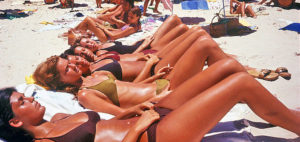One of the few skills I’ve retained from my teen years in the public school system of mid-Nineties America is the ability to get undressed in front of people without ever actually being naked. It is an art form particular to girls of a certain age, mastered in the locker room in the five minutes between gym class and the rest of the day: a sort of anti-strip tease in which you take off your sports bra while still wearing a T-shirt, always taking care not to expose so much as a millimetre of bare breast.
This method of bra removal was part of a larger, elaborate set of rules, unwritten but ironclad, whereby the locker room was a place to be naked as little as humanly possible. Being in your underwear was okay, but only if you were clearly making haste to put on more clothing. The bathing facilities, it was understood, were for decoration only and not to be used; people still talked about the time a few years back when a girl named Katie, a transfer student from some other country, or possibly another planet, actually took a shower after gym class one day — here you would lower your voice to a dramatic whisper — in the nude.
This cautionary tale of Katie revealed the true nature of our shared pathology: it wasn’t just that we didn’t want to be seen naked, or to see each other naked. It was that allowing yourself to be seen naked signified something sinister about you. You had to be some kind of pervert, an exhibitionist weirdo who lacked the good sense to be ashamed of your body — which was, of course, disgusting, and should be hidden at all costs.
Obviously, this was not a healthy way to be. Obviously, we all had eating disorders. Obviously, the kids were not, in this particular case, all right — or right at all. It’s strange, then, that in 2023, the neuroses of a bunch of 15-year-old girls trying to hide their developing bodies from each other in an upstate New York locker room seem to have somehow become the basis for a new Western paradigm. Nudity is now seen as invariably sexual, highly suspicious, and probably dangerous, particularly to children.
In the UK, uproar recently followed the release of a TV series called Naked Education, in which a group of adult educators appeared in front of teen students fully unclothed, as part of a lesson about the diversity of the human form. In Australia, a surf club banned members from being nude in its changing rooms — including in the showers — in the name of protecting children from the traumatic sight of naked adults. In the United States, the principal of a school in Tallahassee, Florida, was forced to resign after three parents complained about students having seen a picture of Michelangelo’s David sculpture during art class, stone penis and all. To be fair, this last incident may be somewhat more complicated than the initial reporting made it seem — but the powerful prudery it implies has form. In 2002, for instance, two statues in the Justice Department’s Great Hall were ordered to be shielded by drapes, because Attorney General John Ashcroft was apparently perturbed by the Spirit of Justice’s stone breast lurking over his shoulder in photographs.
Of course, decompensating over the sight of a naked body — supposedly to protect children — is itself bizarrely childish. It is reminiscent of a scene in Love Actually where an increasingly exasperated Andrew Lincoln instructs a group of giggling schoolgirls that the photograph they’re laughing at — a rear view of several men wearing Santa hats and nothing else — is “not funny, it’s art!” (This job was admittedly not made easier by the fact that at least some of these photos were, objectively, ridiculous.) And there’s something very teenaged, too, about the inability to divorce nudity from its naughtier, sexier contexts — as if nudity which fails to titillate is not just taboo, but actually repulsive. It’s the Seinfeld episode about good versus bad naked (remember: “Naked hair brushing, good! Naked crouching, bad”), all grown up and coming soon to a set of locker room bylaws near you.
It’s not hard to understand how we got here. The mass awareness-raising of the #MeToo movement does not mix well with the ongoing brouhaha over sex and gender education in schools. And with the rare but highly-publicised instance wherein a genuine pervert exploits the availability of clothing-optional environments for his own unsavoury purposes, some people were always going to decide that we’re better safe (and fully clothed) than sorry. But what happens to a society in which the concept of non-sexualised nudity simply ceases to exist? It’s not just art that gets weird; it’s everything.
The importance of non-sexual nudity is less about pleasing the eyes than calming the mind: in this space you can be naked without worrying about what you look like naked. In cultures with fewer sexual hang-ups, nudity can even be an ice-breaker. Among young folk in Stockholm, a friend recently explained, the co-ed sauna can be a first date destination, ostensibly to remove the pressure of wondering if and when you’ll be naked together, so that you can focus on more important areas of compatibility.
I can understand the appeal of this approach, particularly for those who haven’t yet reached that age when going into a hot room naked causes even the normally-supple parts of your body to start melting, Jabba-the-Hutt-like, toward the floor. Even leaving aside the aesthetic benefits of being young, hot and in the nude, there’s also the intimacy of it. Not intimacy as in physical, but the kind where you don’t rush to cover your cellulite with a blanket the second the lights come on. The “I’ll let you see my flaccid penis in a hot room” kind of intimacy. The kind where you are unguarded and unselfconscious, allowing yourself to be seen.
Meanwhile, the more taboo nudity becomes in America, the more people seem to seek out ever more elaborate pretences for getting naked. Naked yoga classes. Naked dinner parties. Naked bowling nights! (Yes, you can bring your own balls.) Or how about Naked and Afraid, a reality survival series in which the only exciting part of the contestants’ titular nudity is the possibility that one of them, at any moment, might be bitten on the genitals by a venomous snake. Despite the supposedly traumatising nature of naked bodies, it’s almost like we’re aching to be naked, and to see other people that way — in contexts where sex is a distant afterthought.
In a moment when trust is in short supply — not just between individuals in intimate relationships, but on a societal scale — perhaps the desire to curtail nudity stands in for a fear of intimacy, and from the sense that we just can’t tolerate being so vulnerable around people we don’t know well. It’s an irony of our hyperconnected moment that we are more suspicious of each other than ever, more obsessed with catching each other — ideally on video — in violation of whatever social edicts that convey in-group status. Social media has given us an unprecedented window into other people’s heads, only to leave us consumed by fear of all the things we’re sure they’re thinking but not saying. Our most popular social movements, from #MeToo to MAGA, are at least partially premised on the notion that other people are secret sexual predators, or violent bigots, or sneering elites; in any case, they hate you, and wish to do you harm.
But when we set out to “protect” young people from predation by shielding them from the sight of a naked body in any context, what are we really teaching them to avoid, to be afraid of? Just like in that gym locker room all those years ago, the message seems to be not just that it’s dangerous to see nudity, or dangerous to be nude; it’s also that there’s something unseemly about being okay with being naked, be it literally or figuratively. Don’t you realise that your true shape is disgusting? Don’t you know you’re supposed to be ashamed?
Anyway, because teenagers are the way they are, all we’re really doing by shielding them from nudity is allowing their entire education about the normal range of human anatomy to be dictated by the material they seek out on their own — which is to say, by porn. Needless to say, this is a bad way for kids to form a factually accurate understanding of what normal naked bodies look like, never mind what it teaches them about sex. But it also reinforces the notion that the two can’t ever be separated.
Surely this undermines what young people should actually learn about the human body: that it’s not just a vehicle for sexual activity, or an object of sexual desire, but a miraculous machine in its own right, the vessel that moves us through the world and contains everything that we are. And surely what we should strive for is a world in which people can sometimes be naked — not performatively, not gratuitously, but in the unselfconscious way of a person who takes off her sweaty clothes and gets in the shower, because there is a shower, and that is what a shower is for.
This is the thing I’ve realised about Katie, all these years later: she was the only one being normal. The rest of us, nearly strangling ourselves with our own undergarments in our desperation not to be seen naked, were the weird ones.
Disclaimer
Some of the posts we share are controversial and we do not necessarily agree with them in the whole extend. Sometimes we agree with the content or part of it but we do not agree with the narration or language. Nevertheless we find them somehow interesting, valuable and/or informative or we share them, because we strongly believe in freedom of speech, free press and journalism. We strongly encourage you to have a critical approach to all the content, do your own research and analysis to build your own opinion.
We would be glad to have your feedback.
Source: UnHerd Read the original article here: https://unherd.com/



